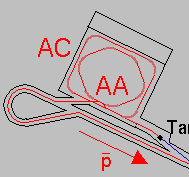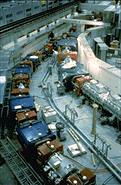

Schematic of CERN's antiproton complex until 1996 (click for the full view)
CERN's Antiproton Collector (AC) and CERN's Antiproton Accumulator (AA)
What is the AD?
The Antiproton Decelerator is a very special machine compared to what already exists at CERN and other laboratories around the world. So far, an "antiparticle factory" consisted of a chain of several accelerators, each one performing one of the steps needed to produce antiparticles. The CERN antiproton complex is a very good example of this.
At the end of the 70's CERN built an antiproton source called the Antiproton Accumulator (AA). Its task was to produce and accumulate high energy antiprotons to feed into the SPS in order to transform it into a "proton-antiproton collider".
As soon as antiprotons became available, physicists realized how much could be learned by using them at low energy, so CERN decided to build a new machine: LEAR, the Low Energy Antiproton Ring. Antiprotons accumulated in the AA were extracted, decelerated in the PS and then injected into LEAR for further deceleration. In 1986 a second ring, the Antiproton Collector (AC), was built around the existing AA in order to improve the antiproton production rate by a factor of 10.
The AC is now being transformed into the AD, which will perform all the tasks that the AC, AA, PS and LEAR used to do with antiprotons, i.e. produce, collect, cool, decelerate and eventually extract them to the experiments.


